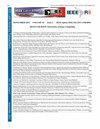COVID-19 impact in the Brazilian Multiplex Air Transportation Network
IF 1.3
4区 工程技术
Q3 COMPUTER SCIENCE, INFORMATION SYSTEMS
引用次数: 0
Abstract
The Brazilian Air Transportation Network has been changing in the last years, due to an economic recession since 2016, the concession of the main airports and the impact of the COVID-19 pandemic. Air transportation is a complex infrastructure system, in which each airline represents a different layer. Adding the weight of interactions combined with a multilayer approach can make the network description even more detailed than a single-layer analysis, because important network features emerge from the multilayer character. The multilayer approach for complex networks is yet new in the literature. As far as the authors know, there are no studies yet applying multiplex network to analyze domestic and international Brazilian air network to improve the understanding of complex systems and investigate macroeconomic effects of the economic recession and COVID-19 pandemic in the air network. The objective of this paper is to evaluate changes in the Brazilian Air Transportation network from 2019 to 2020, before and during the COVID-19 pandemic, using topology measures for network characterization. We compared the network topology and evaluated COVID-19 impact on airports under concession and on regional aviation, also comparing with the aggregated approach. Results show a network concentration during this period in hub airports, reduced connectivity and reduced density resulting in a sparser network. The airlines strategies were different over this period and the multilayer approach changed the importance ranking of airports compared with the aggregated approach. These analyses indicate an opportunity to improve regional air transportation and the need to enhance regional airports versatility.2019冠状病毒病对巴西多元航空运输网络的影响
由于2016年以来的经济衰退、主要机场的特许经营以及COVID-19大流行的影响,巴西航空运输网络在过去几年中一直在发生变化。航空运输是一个复杂的基础设施系统,每个航空公司都代表着不同的层面。增加相互作用的权重与多层方法相结合,可以使网络描述比单层分析更详细,因为重要的网络特征来自多层特征。复杂网络的多层方法在文献中是新的。据作者所知,目前还没有研究应用多路网络来分析巴西国内和国际航空网络,以提高对复杂系统的理解,并研究经济衰退和COVID-19大流行对航空网络的宏观经济影响。本文的目的是评估2019年至2020年,在COVID-19大流行之前和期间,巴西航空运输网络的变化,使用拓扑度量进行网络表征。我们比较了网络拓扑结构,评估了COVID-19对特许机场和区域航空的影响,并与综合方法进行了比较。结果表明,在此期间,枢纽机场的网络集中,连通性降低,密度降低,导致网络稀疏。在此期间,航空公司的策略有所不同,多层方法与综合方法相比改变了机场的重要性排名。这些分析表明,有机会改善区域航空运输,有必要提高区域机场的通用性。
本文章由计算机程序翻译,如有差异,请以英文原文为准。
求助全文
约1分钟内获得全文
求助全文
来源期刊

IEEE Latin America Transactions
COMPUTER SCIENCE, INFORMATION SYSTEMS-ENGINEERING, ELECTRICAL & ELECTRONIC
CiteScore
3.50
自引率
7.70%
发文量
192
审稿时长
3-8 weeks
期刊介绍:
IEEE Latin America Transactions (IEEE LATAM) is an interdisciplinary journal focused on the dissemination of original and quality research papers / review articles in Spanish and Portuguese of emerging topics in three main areas: Computing, Electric Energy and Electronics. Some of the sub-areas of the journal are, but not limited to: Automatic control, communications, instrumentation, artificial intelligence, power and industrial electronics, fault diagnosis and detection, transportation electrification, internet of things, electrical machines, circuits and systems, biomedicine and biomedical / haptic applications, secure communications, robotics, sensors and actuators, computer networks, smart grids, among others.
 求助内容:
求助内容: 应助结果提醒方式:
应助结果提醒方式:


